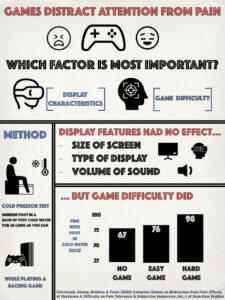Medical professionals know that distraction is an effective way to distract the patient from a painful procedure, especially when the patient is a child. As a result, there is a lot of work devoted to understanding how technology can distract from pain, particularly using VR in the clinic. The basic idea here is that VR and related technologies have an immersive quality and it is this immersive quality that enables distraction from pain.
When you start to dig into the semantics of immersive technologies, it’s clear that the word is being used in slightly different ways. For VR research, immersion is about creating a convincing illusion of place and an equally convincing version of the body to move through this virtual space. With respect to gaming research, immersion is a graded state of attention experienced by the player of the game. Some games can be played while the player conducts a conversation with someone else, others make more strenuous demands and require total concentration, evoking grunts or monosyllables to any unwelcome attempts at conversations – and a small number of games occupy attention so completely that any attempt to converse will not even be heard by the player.
Moving away from technology, there’s also a load of work in the field of pain research on the relationship between selective attention and pain. According to this perspective, painful sensations call attention to themselves at source, whatever that is, either a hand placed unthinkingly on a hot oven or a foot pierced by a nail. This cry for attention interrupts all other thought processes if the pain is extreme, and so it should from an evolutionary perspective. But the evidence suggests that awareness of painful sensations can be reduced (and tolerance for pain enhanced) by having participants perform cognitive tasks that are very demanding, such as memorising material or doing mental arithmetic. High levels of concentration on a cognitive task makes it harder for painful sensations to call attention to themselves.
So, we see an obvious point of convergence between games and research into pain, namely that painful sensations require attention, which is limited and highly selective, hence we can ‘dampen’ attention to pain by providing the person with an activity that fully occupies their attentional capacity.
We recently published an experimental paper on the relationship between immersion during gaming and the experience of pain in the International Journal of Human-Computer Studies. The infographic at the top of this post gives a brief study of the work and the four studies included in the paper.
The work was motivated by a desire to understand the influence of two contributions to immersive experiences during games: hardware quality and cognitive demands. Playing a game in VR or on a huge 4K TV screen with surround sound is great of course, but are those kinds of high quality ‘immersive’ displays necessary for distraction from pain? On the flip side of this coin, we have the level of cognitive engagement required to interact with the technology. Engagement can be described as the level of effortful striving required to fulfil the goals of the game. This dimension captures the level of mental and perceptual demands made on the person by the game. In order for a game (any kind of task) to attract selective attention, it is important for the player to engage with the mechanics and the goals of the game.
In the paper, we conducted four studies to understand the influence of hardware and cognition on pain tolerance during game play. We started from the position that highest pain tolerance would be observed when display was immersive and cognitive engagement was high.
